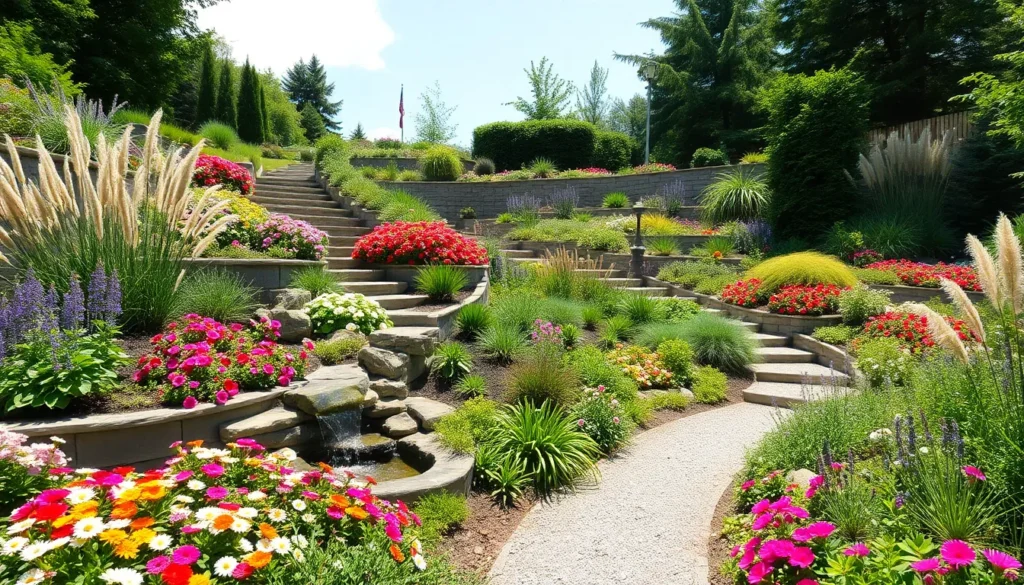Transforming a sloped yard from a landscaping challenge into your dream garden isn’t just possible – it’s an opportunity to create something truly spectacular. We’ve all stared at that awkward hillside wondering how to make it both beautiful and functional without very costly or watching our topsoil wash away with the next heavy rain.
Sloped gardens offer unique advantages that flat yards simply can’t match. You’ll discover natural drainage answers terraced planting beds and stunning multi-level designs that add incredible depth and visual interest to your outdoor space. The key lies in working with your slope’s natural characteristics rather than fighting against them.
Whether you’re dealing with a gentle incline or a steep hillside we’ll show you proven strategies that turn challenging terrain into your garden’s greatest asset. From retaining walls and ground covers to creative terracing answers you’re about to unlock your slope’s hidden potential.
Terraced Garden Beds for Maximum Planting Space
Terraced garden beds transform steep slopes into productive growing spaces that maximize every square foot of your hillside terrain. We create these stepped planting areas to prevent soil erosion while dramatically increasing the usable garden space on challenging inclines.
Building Retaining Walls with Natural Stone
Natural stone retaining walls provide the structural foundation that makes terraced gardening possible on slopes. We recommend using fieldstone, limestone, or granite blocks that complement your industry’s existing features while creating sturdy barriers for soil retention.
Choose stones weighing 50-100 pounds each for walls under 3 feet tall, as smaller rocks lack the stability needed for proper soil containment. Stack stones with their longest dimension running perpendicular to the wall face, creating a batter of 1 inch backward for every foot of height.
Install a gravel base 6-8 inches deep beneath your first course of stones to ensure proper drainage and prevent frost heaving. Pack crushed stone firmly and level it before placing your foundation stones to create a stable platform.
Build walls in courses, fitting each stone tightly against its neighbors while maintaining level runs throughout the construction. Fill gaps between stones with smaller pieces rather than mortar, allowing water to drain naturally through the wall structure.
Creating Multi-Level Planting Areas
Multi-level planting areas maximize growing space while creating visual interest across your sloped garden terrain. We design these stepped gardens with varying depths to accommodate different plant types and their exact growing requirements.
Design terraces 3-4 feet wide for vegetable gardens and annual flowers, providing adequate space for plant growth and maintenance access. Create deeper terraces of 6-8 feet for perennial borders and shrub plantings that require more root space.
Space retaining walls 4-6 feet apart vertically to prevent excessive height that could compromise structural integrity. Calculate the number of levels needed by dividing your slope’s total vertical rise by the desired height of each terrace.
Plan plant placement with taller species on upper levels and shorter varieties below to prevent shading issues. Position trees and large shrubs on the lowest terraces where their root systems won’t interfere with upper level structures.
| Terrace Level | Recommended Width | Ideal Plants | Maintenance Access |
|---|---|---|---|
| Upper | 3-4 feet | Herbs, small vegetables | Easy reach |
| Middle | 4-6 feet | Perennials, medium shrubs | Moderate access |
| Lower | 6-8 feet | Trees, large shrubs | Full walkways |
Installing Drainage Systems Between Levels
Drainage systems between terrace levels prevent water buildup that can destabilize retaining walls and damage plant roots. We install these systems during construction to ensure proper water management throughout your terraced garden’s lifespan.
Install French drains behind each retaining wall using 4-inch perforated pipe surrounded by gravel to collect and redirect excess water. Wrap drainage pipe in industry fabric to prevent soil infiltration while maintaining water flow.
Create weep holes every 6-8 feet along stone retaining walls by leaving gaps between stones or installing plastic drainage tubes. Position these openings 6 inches above ground level to allow trapped water to escape naturally.
Grade terraces with a slight slope of 1-2% toward drainage outlets to encourage surface water movement away from planted areas. Connect multiple terrace drains to a main collection system that directs water to appropriate discharge points.
Add gravel channels between planting beds to handle overflow during heavy rainfall events. Line these channels with industry fabric and fill with river rock to create attractive drainage features that complement your garden design.
Rock Gardens That Embrace Natural Slope Contours
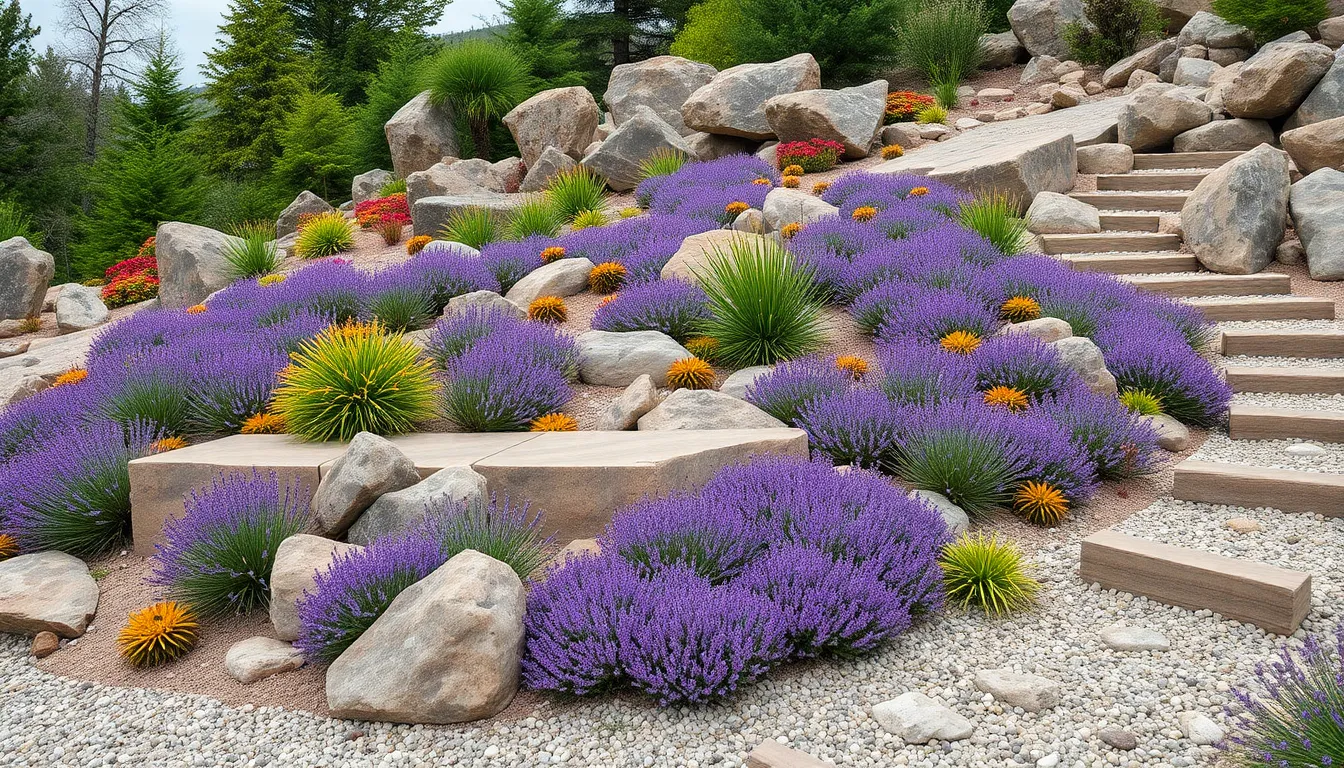
Rock gardens transform challenging slopes into stunning landscapes that work with gravity rather than against it. We’ll show you how to arrange rocks informally to create natural contours that stabilize your terrain while adding visual drama.
Selecting Drought-Tolerant Alpine Plants
Alpine plants excel in sloped rock gardens because they’re naturally adapted to harsh conditions and excellent drainage. Succulents like sedum and sempervivum thrive between rocks while requiring minimal water and maintenance. Heat-loving specimens such as lavender, thyme, and creeping phlox handle the intense sun reflection from surrounding stones.
We recommend choosing plants that tolerate the heat retention rocks naturally create throughout the day. Alpine flowers including saxifrage, aubrieta, and rock cress add colorful blooms while maintaining low growth habits perfect for slope stability. These hardy selections establish quickly in rocky soil and spread naturally to fill gaps between stones.
Positioning Boulders for Visual Anchor Points
Large boulders serve as powerful focal points that guide the eye through your sloped garden design. We position these substantial rocks to create natural barriers that slow water runoff while adding sculptural interest to the industry. Strategic boulder placement helps establish the garden’s visual rhythm by creating stopping points that break up the slope’s continuous line.
Burying one-third to one-half of each boulder ensures proper stability and creates a natural appearance as if the rocks emerged from the hillside over time. Visual anchors work best when positioned at irregular intervals rather than uniform spacing, mimicking how boulders naturally occur in mountain environments.
Creating Gravel Pathways Between Rock Features
Gravel pathways connect different sections of your rock garden while providing excellent drainage throughout the slope. We construct these walkways to guide visitors naturally through the industry, emphasizing the garden’s most attractive features and viewing angles. Decomposed granite or crushed stone creates stable footing that complements the rocky aesthetic.
Pathways help visitors navigate safely while preventing soil compaction around planted areas. We design gravel routes to follow the slope’s natural contours, creating gentle curves that feel organic rather than forced. These practical corridors also serve as visual elements that unify scattered rock groupings into a cohesive garden design.
Ground Cover Solutions to Prevent Soil Erosion
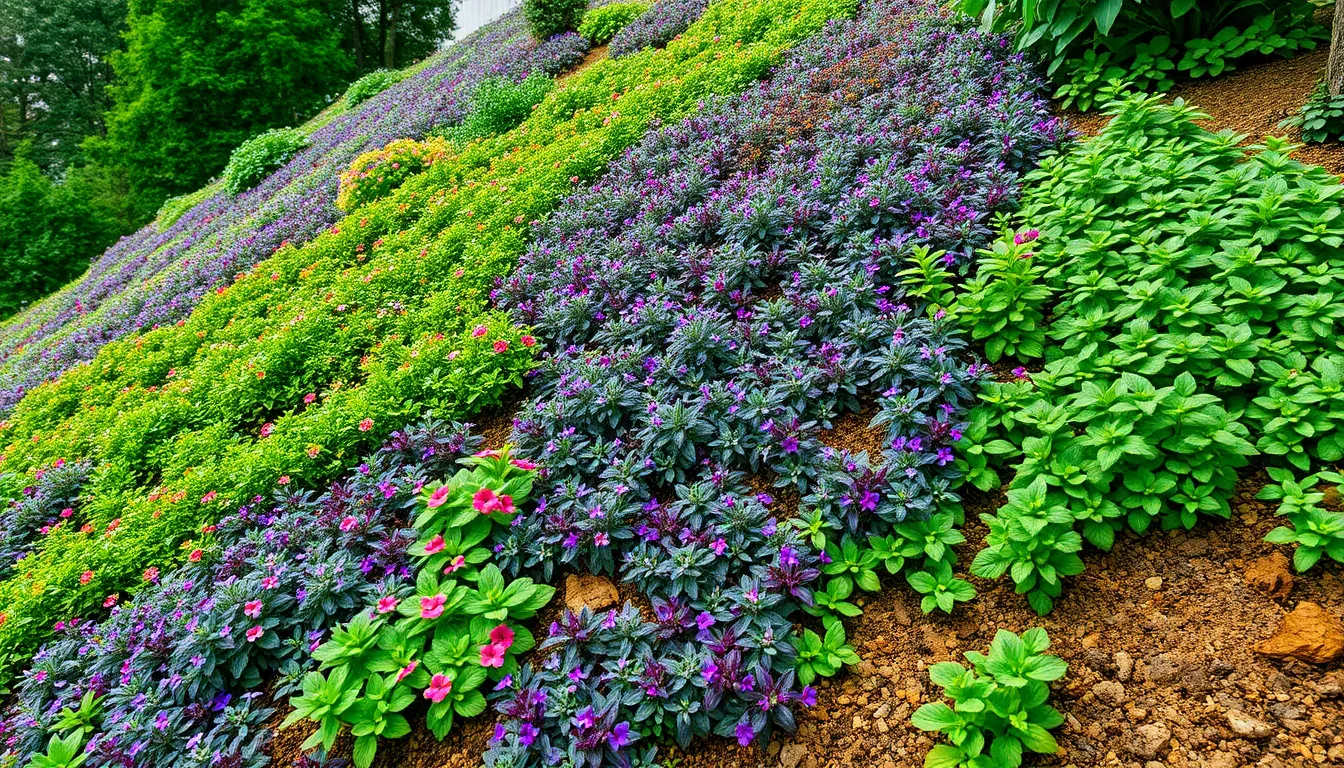
Selecting the right ground cover plants transforms unstable slopes into thriving landscapes that naturally prevent soil erosion. We’ll explore proven options that establish quickly and provide long-term slope stability.
Fast-Spreading Native Plant Options
Creeping Phlox establishes rapidly across sunny slopes while delivering vibrant spring flowers in shades of pink, purple, and white. This drought-tolerant perennial spreads through underground runners, creating a dense mat that effectively binds soil particles together. Ajuga Reptans (Bugleweed) adapts to various light conditions from full sun to partial shade, making it versatile for different slope exposures. Its bronze-purple foliage forms thick colonies that prevent water runoff while producing attractive blue flower spikes in late spring.
Vinca Minor (Periwinkle) thrives in shaded slope areas where other ground covers struggle to establish. This robust spreader creates an evergreen carpet that remains attractive year-round, particularly excelling in areas with dappled sunlight under trees. Japanese Spurge develops dense growth patterns that effectively stabilize soil through its extensive root network, making it ideal for steep grades where erosion control is critical.
Deep-Rooted Perennials for Slope Stability
Forsythia anchors slopes with its extensive root system while providing spectacular yellow blooms in early spring before leaves emerge. These shrubs develop deep taproots that penetrate several feet into the soil, creating natural reinforcement against erosion. We recommend planting forsythia in clusters of three to five plants for maximum visual impact and soil stabilization.
Low Sumac produces dense stem growth that creates an impenetrable barrier against soil movement on steep hillsides. This native shrub develops multiple stems from its base, forming a living retaining wall that’s particularly effective on challenging grades. Sumac’s aggressive spreading habit makes it perfect for large slope areas where rapid coverage is essential.
Living Mulch Alternatives for Steep Areas
Spotted Dead Nettle functions as natural mulch by forming dense mats that reduce water runoff and suppress weed growth. This ground cover adapts to various soil types while maintaining consistent coverage throughout the growing season. Its silver-spotted leaves and purple flowers add visual interest while performing essential erosion control functions.
Creeping Junipers excel in rocky or sandy soils where traditional plants struggle to establish, creating evergreen carpets that persist through harsh weather conditions. These hardy conifers require minimal maintenance once established, making them cost-effective answers for large slope areas. We’ve found that combining creeping junipers with native grasses creates the most effective living mulch system for steep terrain management.
Stepped Pathway Systems for Safe Navigation

Safe navigation becomes essential when we’re working with sloped terrain that requires reliable access throughout our garden spaces. Well-designed pathway systems transform challenging slopes into accessible industry features while improving the overall aesthetic appeal.
Flagstone Steps with Built-In Planters
Flagstone steps create visually appealing pathways that blend seamlessly with natural garden environments. We recommend installing built-in planters directly into the step design to add greenery and soften the harsh edges of hardscaping materials. These integrated planters serve dual purposes by providing growing space for low-maintenance plants while creating natural barriers that guide foot traffic along designated routes.
Construction involves setting flagstone treads at appropriate rise and run measurements, typically 6-7 inches in height with 12-inch depth for comfortable walking. Built-in planters can be formed using the same flagstone materials or complementary natural stone, creating pockets 8-12 inches deep for adequate root development. Popular plant choices include creeping thyme, sedum varieties, and small ornamental grasses that won’t interfere with safe passage.
Timber Stairways with Integrated Lighting
Timber stairways blend naturally with surrounding vegetation and provide a warm, organic feel to sloped gardens. We find that pressure-treated lumber or naturally rot-resistant woods like cedar offer the best longevity for outdoor stair construction. Integrated lighting enhances both visibility and ambiance, making these pathways safe for evening use while creating dramatic focal points after dark.
LED strip lighting installed beneath each tread creates subtle illumination that highlights step edges without overwhelming the natural environment. Solar-powered options reduce installation complexity and eliminate ongoing electrical costs. We recommend spacing lights every 18-24 inches along handrails for optimal visibility while maintaining energy efficiency.
Gravel and Mulch Walking Trails
Gravel and mulch trails provide low-maintenance options for handling sloping gardens while offering excellent drainage properties. These materials help prevent erosion by allowing water to infiltrate slowly rather than rushing downhill. We use decomposed granite or fine gravel (1/4 inch or smaller) combined with organic mulch to create stable walking surfaces that complement natural landscaping.
Installation involves excavating 3-4 inches deep and laying industry fabric before adding base materials. The combination of gravel and mulch creates natural-looking pathways that require minimal upkeep while providing sure footing on moderate slopes. Regular maintenance includes occasional raking and replenishing materials as they settle or decompose over time.
Water Features That Work with Gravity Flow
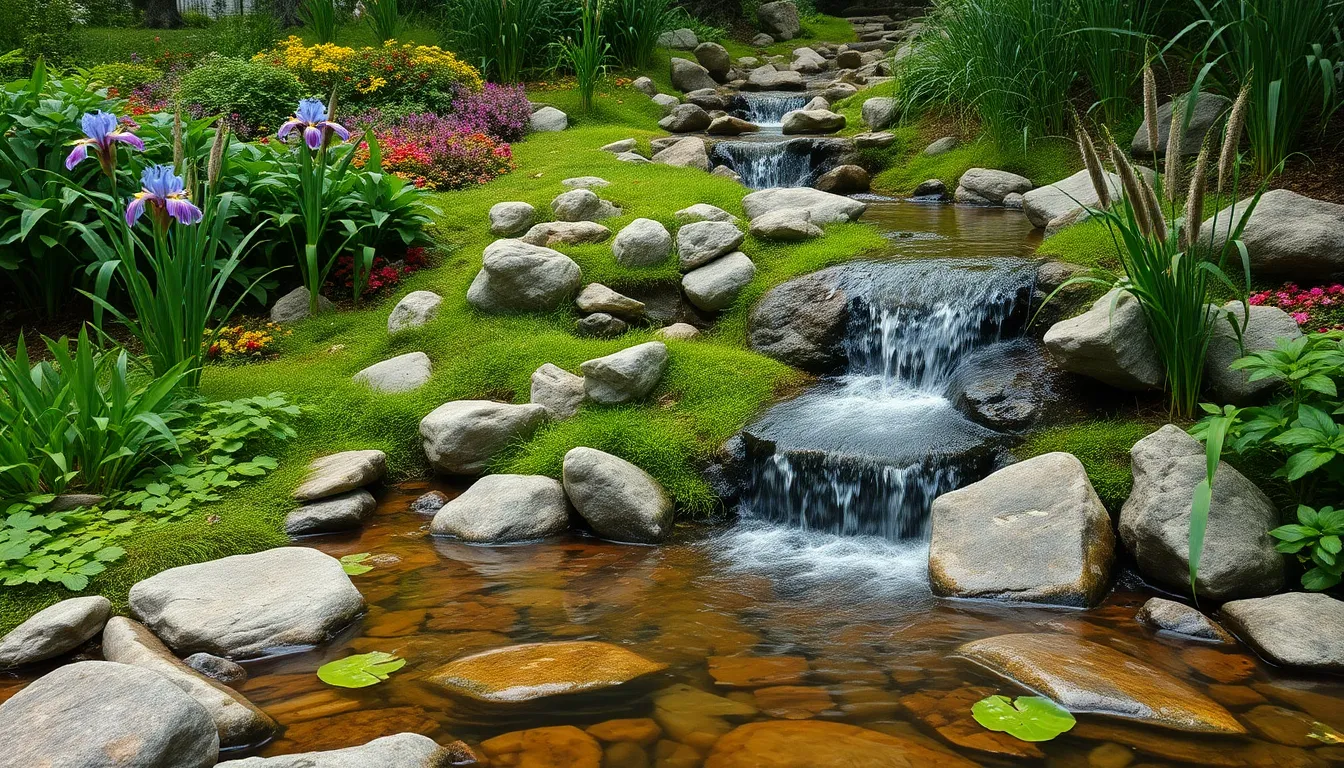
Sloped gardens naturally lend themselves to stunning water features that harness gravity’s power. We can transform challenging drainage issues into beautiful focal points that enhance both functionality and visual appeal.
Cascading Stream Gardens Down the Slope
Cascading stream gardens use your slope’s natural gradient to create flowing water features that descend gracefully down the terrain. We recommend starting with a water source at the highest point and allowing gravity to guide the flow through carefully positioned rocks and planted areas.
Small waterfalls can be incorporated at various intervals to create visual and auditory interest throughout the descent. The sound of moving water masks neighborhood noise while attracting beneficial wildlife like birds and butterflies to your garden space.
Stone placement becomes crucial for directing water flow and creating natural pools along the stream’s path. We suggest using larger boulders as anchor points and smaller rocks to fine tune the water’s movement and speed.
Native aquatic plants like water iris and cattails thrive in these stream environments while helping to filter the water naturally. These plantings also provide habitat for frogs and other beneficial garden creatures.
Rain Gardens at Natural Collection Points
Rain gardens transform areas where water naturally collects into functional and attractive industry features. We identify these collection points by observing where rainwater pools after storms and design specialized planting areas to manage this runoff effectively.
These gardens serve dual purposes by preventing erosion while creating unique planting opportunities for moisture loving plants. Native sedges, ferns, and wildflowers excel in these consistently moist conditions and require minimal maintenance once established.
Proper sizing ensures rain gardens can handle typical storm volumes without overflowing into unwanted areas. We calculate approximately 20 to 30 percent of the drainage area’s size for optimal water management capacity.
Mulching around rain garden plants helps retain moisture during dry periods while preventing weed growth. Organic mulches like shredded bark or leaf mold work exceptionally well in these moisture rich environments.
Decorative Drainage Channels as Design Elements
Decorative drainage channels combine practical water management with stunning visual appeal throughout your sloped garden. We design these channels to follow natural contours while creating attractive pathways for water flow during heavy rains.
Stone lined channels can feature decorative river rocks or pebbles that add texture and interest even when dry. These materials also help slow water flow and prevent erosion while maintaining the channel’s structural integrity over time.
Planted drainage swales incorporate drought tolerant grasses and perennials along the channel edges for year round beauty. These plantings help filter runoff while softening the hardscape elements with natural color and movement.
Integration with existing pathways and garden beds ensures drainage channels enhance rather than interrupt your overall industry design. We position these features to complement retaining walls and terraced areas for maximum visual cohesion.
Raised Planter Boxes for Easier Maintenance
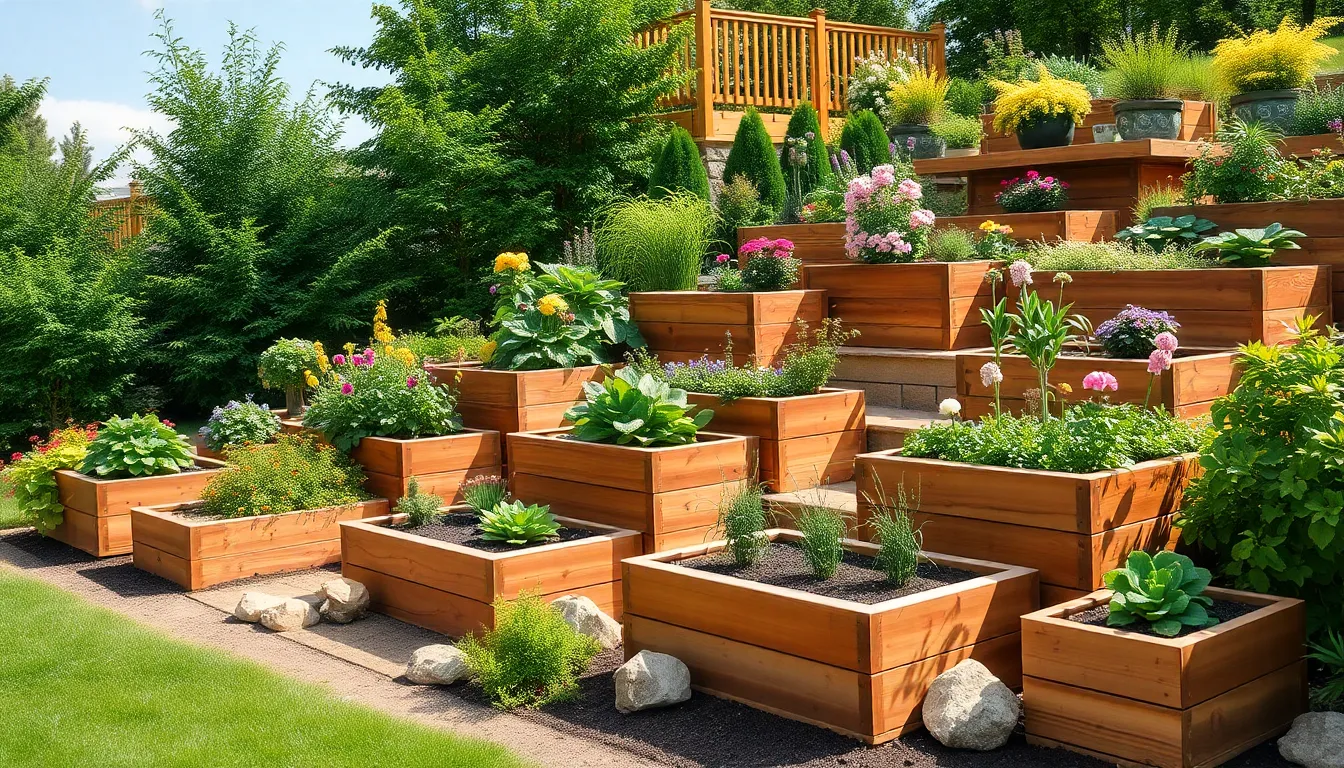
Raised planter boxes transform sloped gardens into manageable growing spaces that deliver superior drainage and simplified upkeep. We’ll explore how these elevated answers create level planting surfaces while working with your slope’s natural characteristics.
Tiered Container Gardens on Slope Platforms
Creating terraced platforms allows for better drainage and prevents soil erosion. We recommend building stepped levels using retaining walls or large stones to support each tier. Each platform should measure 3-4 feet deep to accommodate various container sizes while maintaining easy access for maintenance.
Container variety enhances both function and visual appeal across your tiered system. We suggest combining large 20-gallon containers for vegetables with smaller 5-gallon pots for herbs and flowers. Mixed container heights create ever-changing visual interest while accommodating different root systems and plant growth requirements.
Platform construction requires careful attention to drainage between each level. We install gravel bases under each tier to prevent water pooling and ensure proper runoff. French drain systems between platforms channel excess water away from plant roots while protecting the structural integrity of your slope.
Built-In Seating with Integrated Planters
Design integration maximizes space efficiency by incorporating seating areas directly into your planter system. We create dual-purpose structures using planters that double as comfortable benches along the slope. These integrated designs typically feature 18-inch heights that work perfectly for both seating and optimal planting depth.
Material selection impacts both durability and comfort for your integrated seating planters. We recommend recycled plastic lumber or cedar wood construction for weather resistance and longevity. Composite materials withstand slope stress while requiring minimal maintenance compared to traditional wood options.
Strategic placement enhances garden accessibility throughout your sloped terrain. We position integrated seating planters at natural rest points along pathways and viewing areas. These locations provide convenient spots for garden maintenance while creating focal points that break up the visual monotony of continuous slopes.
Modular Systems for Flexible Design Changes
Modularity enables easy reconfiguration as your garden needs evolve over seasons and years. We design modular raised bed systems using standardized components that connect seamlessly without permanent installation. These flexible frameworks allow you to expand, reduce, or relocate planting areas based on plant performance and changing preferences.
Customization options accommodate diverse growing requirements across your sloped garden space. We create modular units in multiple sizes ranging from 2×4 feet for herbs to 4×8 feet for larger vegetables. Adjustable leg systems compensate for slope variations while maintaining level planting surfaces throughout your garden.
Installation simplicity reduces setup time and effort compared to permanent raised bed construction. We use modular systems that require no tools or specialized skills for assembly and adjustment. Quick-connect hardware and lightweight materials make seasonal reconfiguration possible while maintaining structural stability on challenging slopes.
Ornamental Grass Landscapes for Low Maintenance
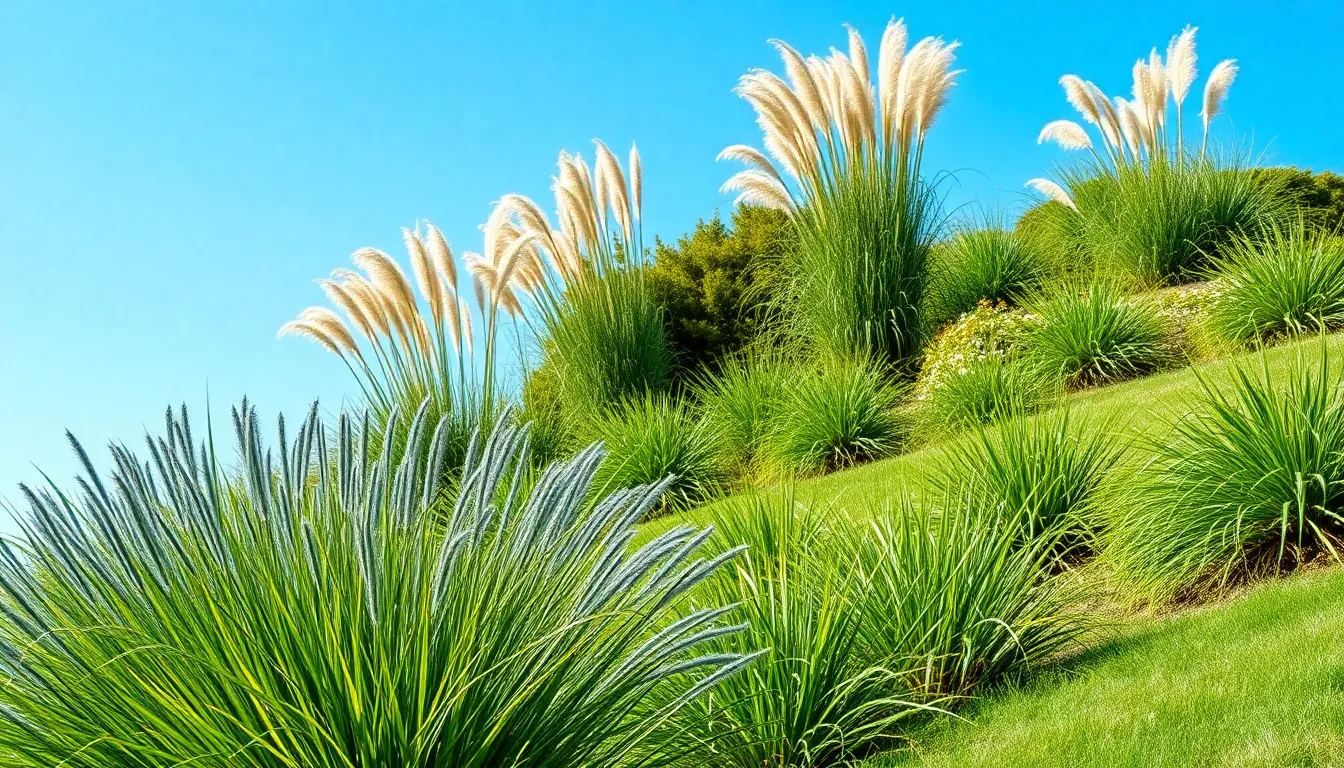
We can transform challenging slopes into stunning, low maintenance landscapes using ornamental grasses that naturally stabilize soil while creating year-round visual appeal. These resilient plants offer the perfect solution for sloped gardens, requiring minimal care once established and providing excellent erosion control.
Selecting Grasses for Different Slope Angles
Gentle slopes work best with shorter ornamental grasses that create manageable maintenance zones. Blue Grama Grass establishes quickly on mild inclines, reaching only 12-18 inches tall and requiring trimming just once per year. Buffalo Grass spreads naturally across gentle grades, forming dense mats that prevent soil movement while staying under 6 inches in height.
Moderate slopes benefit from medium height grasses with stronger root systems. Little Bluestem develops extensive underground networks, growing 2-3 feet tall and turning brilliant orange in autumn. Feather Reed Grass stands upright even on 15-20 degree angles, creating vertical columns that break up water flow effectively.
Steeper slopes require deep rooted varieties that anchor firmly into hillsides. Pampas Grass sends roots down 6-8 feet, creating permanent soil stabilization while producing dramatic 8-10 foot plumes. Fountain Grass establishes robust root masses within two growing seasons, preventing erosion on slopes up to 30 degrees while maintaining elegant arching forms.
Creating Texture Contrast with Mixed Heights
Layered plantings create the most visually striking slope gardens by combining grasses of varying heights. Position tall specimens like Miscanthus at 6-8 feet in back areas, medium grasses such as Switch Grass at 3-4 feet in middle zones, and compact varieties like Mondo Grass at 6-12 inches along edges and pathways.
Staggered arrangements prevent monotonous rows while maximizing visual impact. Plant groups of 3-5 identical grasses together, then transition to different varieties every 8-10 feet along the slope. This creates natural drifts that mimic wild grassland patterns while maintaining organized maintenance access.
Textural variety emerges from mixing fine, medium, and coarse grass blades. Combine feathery Japanese Forest Grass with bold Zebra Grass and spiky Blue Fescue to create rich visual tapestries. These contrasting textures catch light differently throughout the day, adding ever-changing interest to static slopes.
Seasonal Interest Through Varied Bloom Times
Spring bloomers kickstart the growing season with early color and movement. Sedge varieties produce delicate flowers in March and April, followed by fresh green growth that contrasts beautifully with dormant winter grasses. Blue Oat Grass develops silvery blue foliage in early spring, creating cool tones before summer heat arrives.
Summer displays reach peak drama with flowering plumes and seed heads. Prairie Dropseed blooms in July with fragrant, airy panicles, while Big Bluestem produces distinctive turkey foot seed heads in August. Fountain Grass creates bottlebrush plumes throughout summer months, attracting birds and adding constant motion to the industry.
Fall transformations deliver the most spectacular color changes as grasses prepare for dormancy. Flame Grass turns brilliant red and orange in September, while Indian Grass develops golden bronze hues that persist through November. Winter interest continues as dried plumes and seed heads provide texture and wildlife habitat until spring cleanup.
Conclusion
We’ve shown you that sloped gardens aren’t obstacles—they’re opportunities waiting to be unlocked. From terraced beds and rock gardens to cascading water features and ornamental grass displays your challenging terrain can become the most stunning part of your industry.
The key lies in working with your slope’s natural characteristics rather than against them. Whether you choose stepped pathways with integrated lighting or drought-tolerant ground covers for erosion control each solution we’ve shared builds upon your land’s existing strengths.
Your sloped garden journey starts with selecting the right combination of techniques for your exact conditions. Remember that the most beautiful hillside gardens develop over time so start with one area and expand your vision as you gain confidence and experience.
Frequently Asked Questions
What are the main advantages of having a sloped garden?
Sloped gardens offer superior natural drainage, prevent water pooling, and create opportunities for multi-level planting designs. They provide better visual interest than flat gardens and allow for terraced growing spaces that maximize planting area while preventing soil erosion.
How do I build stable terraced garden beds on a slope?
Use natural stone retaining walls as structural foundations, ensuring proper spacing between levels. Install drainage systems like French drains and weep holes between terraces to manage water flow. Grade each terrace level and select appropriate plants for different elevation zones.
What are the best ground cover plants for preventing slope erosion?
Fast-spreading native options include Creeping Phlox, Ajuga Reptans, Vinca Minor, and Japanese Spurge. For deeper root systems, consider Forsythia and Low Sumac. Living mulch alternatives like Spotted Dead Nettle and Creeping Junipers also effectively stabilize slopes.
How can I create safe pathways on my sloped garden?
Install stepped pathway systems using flagstone steps with built-in planters or timber stairways with integrated lighting. Gravel and mulch walking trails offer low-maintenance alternatives that provide excellent drainage and prevent erosion while ensuring safe navigation.
What water features work best on sloped terrain?
Cascading stream gardens with small waterfalls utilize gravity flow naturally. Rain gardens at collection points manage water runoff effectively. Decorative drainage channels follow natural contours while serving both practical and aesthetic purposes in your sloped landscape design.
Are raised planter boxes suitable for sloped gardens?
Yes, raised planter boxes transform challenging slopes into manageable growing spaces with superior drainage. Create tiered container gardens using stepped levels supported by retaining walls. Consider modular systems for flexibility and built-in seating with integrated planters for space efficiency.
Which ornamental grasses work best for slope stabilization?
Select grasses based on slope angle and soil conditions. Layer different heights for visual interest – tall grasses like Miscanthus for background, medium varieties for mid-level, and low-growing options for foreground. This creates texture contrast while providing year-round erosion control.
How do I manage drainage in a terraced garden?
Install French drains between terrace levels and include weep holes in retaining walls. Create proper grading that directs water flow toward designated drainage areas. Use gravel pathways and permeable materials to enhance water infiltration and prevent runoff issues.

